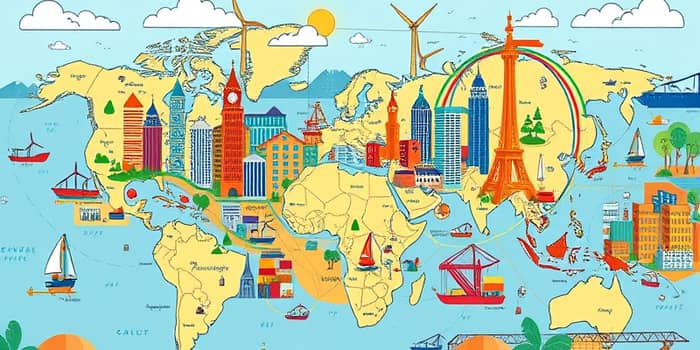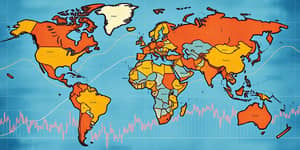As the global economic center of gravity shifts, emerging markets are capturing unprecedented attention. Once seen as volatile peripheries, these economies now account for over half of the world’s purchasing power parity GDP. Investors, businesses, and policymakers are asking: what is the next frontier of growth and innovation? The answer lies in harnessing the rising middle classes and consumer demand that are reshaping trade, technology, and infrastructure worldwide.
Defining Emerging Markets
Emerging markets sit between developing and developed status, marked by rapid industrialization and infrastructure expansion. They exhibit higher-than-average GDP growth—projected at about 3.7% in 2025, compared to 1.4% in advanced economies—and often boast youthful, urbanizing populations. Their financial systems are maturing, with expanding stock markets and banking sectors that still have room to evolve. Between 1960 and 2013, EMs’ share of global PPP-adjusted GDP climbed from 27% to 53%, and forecasts suggest that by 2025, China and India will remain among the world’s top economies by output.
Geography and Growth Hotspots
Emerging markets span continents and cultures, each bringing unique strengths to the global stage. Major regions include:
- Asia: China, India leading in manufacturing, IT services, and urban expansion
- Latin America: Brazil, Mexico benefiting from agriculture, resources, and consumer markets
- Europe: Poland, Turkey, Russia integrating advanced manufacturing and services
- Africa: South Africa, Egypt innovating in fintech, telecommunications, and agriculture
- Middle East: Saudi Arabia, UAE investing heavily in diversification and green energy
The BRICS grouping (Brazil, Russia, India, China, South Africa) exemplifies the clout these markets exert on trade flows, diplomatic influence, and investment patterns.
Opportunities for Investors and Businesses
Companies and capital allocators are drawn to EMs for their large youthful urbanizing populations demanding goods, services, and digital connectivity. Since 2000, exports from these countries have surged by over 460%, and intra-EM trade is strengthening supply chains away from traditional Western hubs.
- Technology and IT services in India, driven by a skilled workforce and cost advantages
- E-commerce and advanced manufacturing hubs emerging across China’s coastal provinces
- Agriculture, consumer goods, and resources in Brazil feeding global markets
- Fintech and digital innovation in African and Southeast Asian economies leapfrogging legacy systems
- Renewable energy and green technologies as EMs pursue sustainability goals
Rapid mobile and internet penetration is unlocking new business models, from digital banking to remote education. As the US’s share as an EM export destination fell from 20% in 2000 to 14% in 2024, regional partnerships are realigning competitive advantages.
Risks and Challenges Ahead
Investors must weigh the promise of growth against significant hurdles. EMs often face political instability and policy unpredictability, with currency swings and commodity dependence amplifying shocks. Inflation remains elevated: average rates near 5% in 2025, though Turkey, Ghana, and Bolivia are wrestling with double-digit peaks while China hovers around 0%.
Regulatory frameworks and governance standards vary widely, and external events—from global financial crises to pandemics—can erode investor confidence rapidly. Infrastructure deficits and underinvestment still limit long-term productivity gains in many regions.
Tectonic Shifts and Resilience
Despite headwinds, several trends are reshaping EM trajectories:
- Resilient domestic demand mitigating external shocks as consumers drive local growth
- Greater monetary policy autonomy, diverging from Western central bank cycles
- Global decoupling favoring intra-regional trade and diversified supply chains
- Commitment to green transition through renewable energy investments
These dynamics underscore how EMs have absorbed lessons from past downturns, building policy buffers that support stability and recovery.
The Road to 2030
Looking ahead, EMs stand at a crossroads defined by demographic dividends and urbanization trends. By 2030, over half of the global urban population will reside in emerging economies, fueling demand for housing, transportation, and services. Digital transformation will continue to unlock efficiencies in healthcare, education, and governance.
Sustainable development goals are driving investments in clean energy, smart cities, and climate resilience. As EMs build out infrastructure—from roads and ports to digital networks—they will reshape global value chains and unlock new corridors of trade and innovation.
Conclusion
Emerging markets are more than statistics; they represent a generational shift in wealth creation, consumption patterns, and geopolitical influence. The balance of risk and reward hinges on rigorous analysis, on-the-ground partnerships, and adaptive strategies that recognize both volatility and potential. By engaging thoughtfully with these dynamic economies, businesses and investors can tap into powerful growth engines that will define the next era of global progress.
References
- https://www.smartling.com/blog/emerging-markets
- https://www.triodos-im.com/articles/2025/emerging-markets-mid-year-2025-investment-outlook
- https://stripe.com/resources/more/emerging-markets
- https://www.robeco.com/en-int/insights/2025/06/why-emerging-markets-are-back-in-focus
- https://en.wikipedia.org/wiki/Emerging_market
- https://www.oecd.org/en/publications/2025/06/oecd-economic-outlook-volume-2025-issue-1_1fd979a8.html
- https://velocityglobal.com/glossary/emerging-markets/










